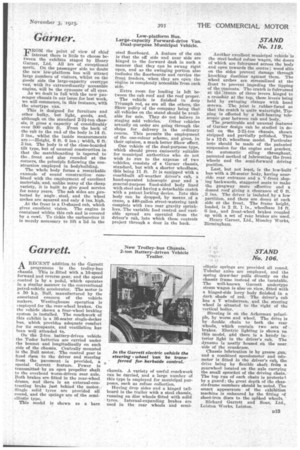Garner.
Page 19

If you've noticed an error in this article please click here to report it so we can fix it.
FROM the point of view of chief interest there is little to choose between the exhibits staged by Henry Garner, Ltd. All are of exceptional merit. On the passenger side no doubt the new low-platform bus will attract large numbers of visitors, whilst on the goods side the large-capacity overtype van, with its extraordinarily accessible engine, will be the cynosure of all eyes.
As we dealt in full with the new passenger chassis in our issue for last week, we will commence, in this instance, with the overtype van.
This is designed for furniture and other bulky, but light, goods, and, although on the standard 2-24-ton chassis, it gives a capacity of considbrably over 500 cubic ft. From the back of the cab to the end of the body is 14 ft. 3 ins., whilst the inside measurements are :—Height, 6 ft. 6 ins.; • width, 6 ft. 3 ins. The body is of the close-boarded tilt type, but of unusual construction in that the matchboarding is tapered to the front and also rounded at the corners, the principle following the construction employed in bodybuilding.
The whole body forms a remarkable example of sound construction combined with the employment of excellent materials, and, unlike many of the cheap variety, it is built to give good service for many years. The ash sides are ,protected by angle steel, and the wheel arches are squared and only 4 ins. high.
At the front is a ID-shaped cab, which gives excellent vision. The engine is contained within this cab and is covered by a cowl. To tickle the carburetter it is merely necessary to lift a lid in the steel floorboard. A feature of the cab is that the off side and near side are hinged to the forward dash in such a manner that they can be swung right open, and as the swinging portion also includes the floorboards and carries the front fenders, when they are open the , . engine is completely aceesiible from each side.
Extra room for loading is left between the cab roof and the roof proper.
The vehicle is finished in deep Triumph red, as are all the others, the Show policy of the company being that all vehicles on the stand should be available for sale. They do not believe in
staging sold vehicles. Other vehicles actually on order are going through the shops for delivery in the ordinary course. This permits the einployment of the one-colour scheme, and gives, in their opinion, a much better Show effect.
One vehicle of the dual-purpose type, which should prove eminently suitable for municipal authorities who do not wish to run to the expense of two vehicles, consists of a Garner chassis, standard, but with a shorter wheelbase, this being 11 ft. It is equipped with a coachbuilt an-weather driver's cab, a hand-operated telescopic gear and a general-purpose fixed-sided body lined with steel and having a detachable cratch with a patent locking device. Into this body can be dropped, by means of a crane, a 440-gallon street-watering tank complete with two rear gravity sprinkler. The variable feed control and variable spread are operated from the driver's cab, into which these controls project through a door in the back.
Another excellent municipal vehicle is the steel-bodied refuse wagon, the doors of which are fulcrtimed across the body and open towards the centre; wood ells on the sides prevent damage through knocking dustbins against them. The wheel arches are streamlined at the front to prevent impeding the tipping of the contents. The cratch is fulcrumed at the 'centre of three levers hinged to•a crossbar at the top, these levers being
held by swinging clamps with hand screws. • The joint is rubber-faced so that the cratCh is quite watertight. Tipping is effected by a ball-bearing telescopic gear between cab and body.
The practicable and unusual features of Garner design cab be studied in detail on the 2-2A-ton chassis, shown stripped and partially polished. This is a 12-ft. wheelbase model. Particular note should be made of the patented suspension for the engine and gearbox, the automatic oiling throughout, patented method of lubricating the front wheels and the semi-forward driving position.
Last, but not least, is the low-built bus with a 26-seater body, having nearside rear entrance and a V-front sloping backwards, staggered seats to make the gangway more effective and a domed roof giving a clearance of 6 ft. 2 ins. The driver is isolated by a low partition, and there are doors at each side at the front. The frame height, loaded, is 2 ft. 1 in., wheelbase 14 ft. 6 ins., and front-wheel brakes coupled up with a set of rear brakes are used.
Henry Garner, Ltd., 'Moseley Works, Birmingham.
















































































